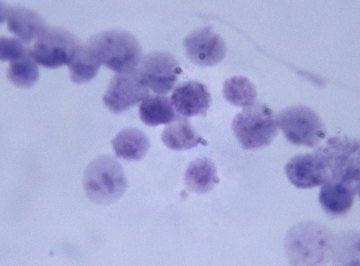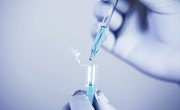
Cells contain DNA, which serves as a blueprint for proteins that each cell can make for use throughout the organism. The purpose of ribosomes -- their biological function -- is to read copies of that blueprint and assemble the long molecular chains that become proteins. Ribosomes function in an animal cell or plant cell by making use of RNA, a molecule closely related to DNA. To accomplish thier important task, ribosomes are found throughout the cell, with their locations reflecting the destination of the proteins they produce.
The Nucleolus
In a eukaryotic cell, a cell with a nucleus, ribosomes begin in a specialized part of the nucleus called the nucleolus. The nucleolus is a cluster of DNA containing genes that carry the code for one ribosomal component, a molecule called ribosomal RNA that is closely related to DNA. Ribosomal RNA is synthesized and bound to proteins in the nucleolus, then exported from the nucleus to form ribosomes. Prokaryotic cells, which lack nuclei, perform this process in the cytoplasm.
The Cytoplasm
Even though prokaryotic cells and eukaryotic cells make their ribosomes at different sites within the cell, they both have ribosomes floating freely as part of the cytoplasm, the material contained within the cell membrane. Eukaryotic cells' free ribosomes generally are larger than those of prokaryotic cells and contain a greater variety of ribosomal RNA and proteins. However, free ribosomes in both cells are important in assembling the proteins needed for the cell's own processes.
The Endoplasmic Reticulum
Eukaryotic cells have cytoplasmic structures that prokaryotic cells lack. One such structure is the endoplasmic reticulum, or ER, a series of membrane-enclosed channels where the cell makes compounds for use beyond its own cytoplasm. Many ribosomes attach themselves to the ER to make proteins, becoming fixed ribosomes. Proteins made in the ribosome-dotted part of the ER, called “rough ER,” are shipped through ribosome-free smooth ER to become components of the cell membrane or products for other cells to consume.
Mitochondria and Chloroplasts
Some especially complex structures inside eukaryotic cells contain their own genetic material. Mitochondria, which generate energy by breaking down carbohydrates, and chloroplasts, which store energy as sugar for plants, algae and some fungi, have their own DNA along with ribosomes to read its instructions. These ribosomes are small, like prokaryote ribosomes, but still help mitochondria and chloroplasts make proteins, supporting the idea that these structures evolved from bacteria that came to live within larger cells.
References
- The Cell: A Molecular Approach, Second Edition: The Nucleolus; G.M. Cooper
- Florida State University: Molecular Expressions: Ribosomes
- National Institute of General Medical Science: Inside the Cell: Chapter 1: An Owner's Guide to the Cell
- The Cell: A Molecular Approach, Second Edition: Mitochondria; G.M. Cooper
About the Author
Sheila Johnson has been writing professionally since 2008. Her publication credits include work in the magazine "Marvel Spotlight" and in Salem Press' "Critical Survey of Graphic Novels." Johnson holds a Bachelor of Arts in English and a Bachelor of Science in biology from the University of Illinois at Chicago.
Photo Credits
Duncan Smith/Photodisc/Getty Images
